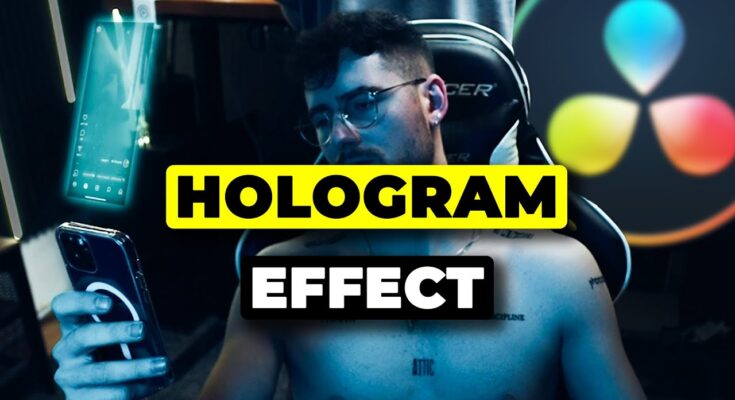The Hologram Animation effect has captured the imaginations of audiences worldwide, appearing in everything from sci-fi movies to high-end tech presentations. The allure of creating 3D-like holographic visuals has also made its way into digital content creation, where artists and filmmakers are now using hologram animation effects to create eye-catching and futuristic scenes. This guide will walk you through the process of creating stunning hologram animations, discuss the software tools you need, and explore practical applications to help you master this trend.
1. What Is the Hologram Animation Effect?
The hologram animation effect creates the illusion of a semi-transparent, three-dimensional object or scene, often with a futuristic blue or cyan glow and digital flickering. This effect simulates holographic imagery by layering motion graphics, blending color schemes, adding lighting effects, and incorporating pixelation and glitches that make the hologram appear more lifelike. Commonly seen in sci-fi movies, hologram animations have made their way into mainstream media, presentations, and even augmented reality (AR) and virtual reality (VR) applications.
2. The Evolution and Popularity of Holograms
Holograms first emerged in science fiction, with iconic scenes in movies like Star Wars depicting holographic characters and interfaces. Over time, real-world technology began to catch up, bringing us closer to producing interactive and 3D-like visuals. In recent years, holographic displays and projections have gained traction in tech events, advertising, and even live performances, such as holographic appearances by celebrities. The rise of VR and AR has also driven the demand for hologram effects, which immerse audiences in hyper-realistic environments and animations.
3. Essential Tools and Software for Creating Hologram Effects
Creating a high-quality hologram effect requires software tools designed for advanced video editing and motion graphics. Here are some popular choices:
Adobe After Effects
Adobe After Effects is the industry standard for creating hologram effects. It allows users to layer effects, add glow, noise, and glitch effects, and customize each element of the animation in great detail. With plug-ins, it’s possible to achieve cinematic holograms with ease.
Blender
Blender is an open-source 3D modeling and animation software that can create holographic objects and scenes from scratch. With Blender, you can work on 3D hologram projects, rendering complex animations with intricate lighting and transparency.
Cinema 4D
Cinema 4D is another powerful tool that combines 3D modeling with motion graphics capabilities. Known for its high-quality render engine, it’s used by professionals to create holograms with realistic textures, reflections, and animations.
Hologram-Specific Plug-ins
Plug-ins like Video Copilot’s Saber (for After Effects) help in adding neon-like glows, and Element 3D enables 3D object integration, adding depth and realism to holograms.
4. Step-by-Step Tutorial: How to Create a Hologram Animation
Creating a hologram effect involves several key elements: layering, adding glow, adjusting transparency, and animating movement. Let’s break down the process in Adobe After Effects, one of the most versatile tools for hologram effects.
Step 1: Preparing Your Footage or Model
Start with a subject you want to turn into a hologram—this could be an image, video, or 3D model. Import this into Adobe After Effects and position it within your composition.
Step 2: Adding a Glow Effect
To give your subject a holographic feel, apply the Glow effect. Adjust the color to a shade of blue or cyan, common colors for holograms. Increase the radius and intensity to give the edges of your subject a glowing aura.
Step 3: Adjusting Opacity
Lower the opacity of your subject to create transparency. Most holograms appear semi-transparent, so adjust the opacity until your subject looks like it’s a part of the environment.
Step 4: Adding Scan Lines
Create a new solid layer and add thin lines to simulate scan lines moving vertically or horizontally across the hologram. Apply an Opacity animation to make these lines flicker subtly.
Step 5: Adding Noise and Distortion
Using Noise and Distortion effects, add slight glitchy movements to give the hologram a realistic, unstable appearance. This effect adds authenticity by simulating the idea that the hologram is being projected.
Step 6: Animating the Entrance
Add keyframes to make your hologram animate onto the screen with a “power-on” look. Start with zero opacity and increase gradually, or add a light beam effect to simulate the projection appearing.
Step 7: Final Touches
Use color grading to match the surrounding scene, and add shadow effects to ground the hologram within the composition. Adjust the glow, opacity, and flickering intensity until the hologram effect is just right.
5. Adding Realism with Advanced Techniques
To take your hologram effect to the next level, consider incorporating the following advanced techniques:
Depth of Field
Add a blur effect to simulate depth of field, making parts of the hologram appear closer or farther. This can be done using Camera Layers in After Effects, which allows you to mimic a 3D perspective.
Reflections and Shadows
Add a subtle shadow or reflection layer to create the impression that the hologram is interacting with the environment around it. This can help ground the hologram and make it look more realistic.
Flicker Effect
Add a random flicker to simulate the projection refreshing or losing signal. You can do this by animating the opacity at various intervals or using a Turbulence effect for random movement.
6. Incorporating Hologram Effects in Videos and Presentations
Integrating hologram animations into your projects can enhance presentations, music videos, and promotional content.
Music Videos and Films
Hologram effects can give a music video a futuristic vibe. Incorporating them into concert footage can also enhance the live experience by projecting virtual performers or digital effects.
Product Promotions
Brands use hologram animations to showcase products in a unique and tech-savvy manner. By layering product images with hologram effects, they can highlight details, features, and interact with virtual customers.
Educational and Corporate Presentations
Using hologram effects in business presentations or educational videos makes complex data and concepts more engaging and understandable, turning dry information into an immersive experience.
7. Tips for Creating Professional-Grade Hologram Effects
To elevate your hologram animations, here are some best practices:
- Keep It Subtle: Less is often more. Avoid overusing effects, as too much distortion or glow can make your hologram appear unrealistic.
- Match the Environment: Pay attention to the colors, lighting, and perspective of the surrounding environment to make the hologram blend seamlessly.
- Use Motion Tracking: When adding a hologram effect to a moving subject or background, use motion tracking to anchor the hologram. This will help maintain realistic positioning.
- Adjust Colors and Transparency Carefully: Make subtle changes to color and opacity to avoid over-saturation or under-realism.
8. Applications of Hologram Animations in Different Industries
The hologram effect has broad applications, far beyond just entertainment:
Healthcare
In the healthcare industry, hologram effects help in creating realistic 3D renderings of organs, procedures, and even patient conditions, aiding in medical education and simulation.
Real Estate
Hologram animations can be used to create virtual tours of properties, allowing potential buyers to view 3D projections of floor plans and room layouts.
Retail and E-commerce
Retailers are using holographic effects to create virtual showrooms and interactive product displays. Customers can view products in 3D without being physically present.
Education and Training
Educational institutions use hologram effects to create interactive lectures and tutorials, turning complex concepts into visual, hands-on experiences for students.
9. Future Trends in Hologram Animation
With advancements in AR and VR, hologram animation is expected to become even more immersive. As technology develops, hologram effects will likely be integrated into wearable tech, AR glasses, and mobile applications, allowing for personal interactions with holographic images and animations in real-time. Moreover, the trend of interactive holograms, where users can manipulate holographic images, will revolutionize various industries, from retail to virtual events.
Download
10. Conclusion: Bringing Futuristic Visuals to Your Work
Mastering the hologram animation effect requires technical knowledge, creativity, and a keen eye for detail. By understanding the principles and techniques behind holograms, you can create visually compelling and professional-grade animations that capture attention and convey complex ideas. With the right tools and a bit of practice, hologram animations can elevate your content and make it stand out in the digital landscape.
For more useful Article keep visit Puletech



